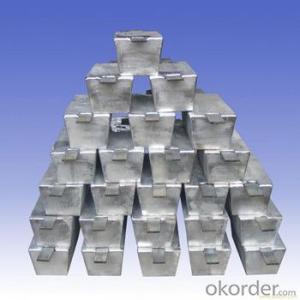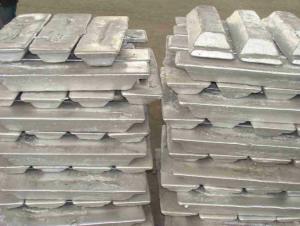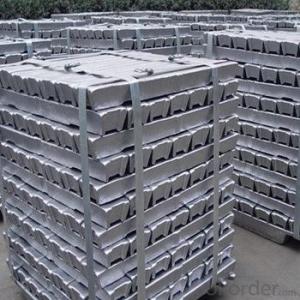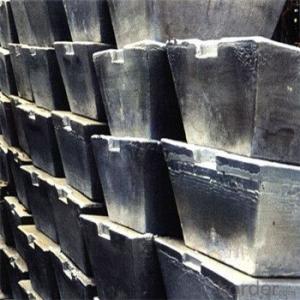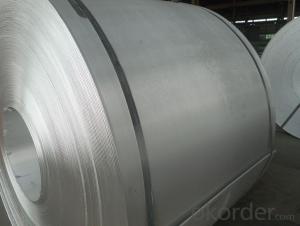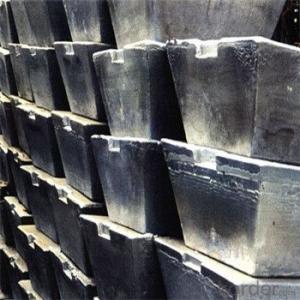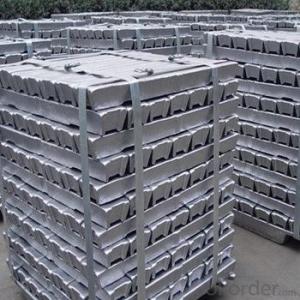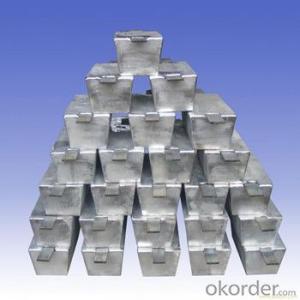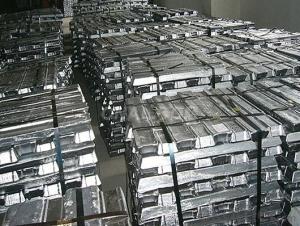Aluminum Pig/Ingot With Different Purity For Choice
- Loading Port:
- China main port
- Payment Terms:
- TT OR LC
- Min Order Qty:
- 1000 m.t.
- Supply Capability:
- 100000 m.t./month
OKorder Service Pledge
OKorder Financial Service
You Might Also Like
Pure Aluminum Pig/Ingot Used for Industry
1.Structure of Aluminum Pig/Ingot
A material that has been cast into a shape in order to be transported and processed easier than in an unprocessed form. An ingot is typically rectangular in shape, which allows it to be stacked. Ingots are most commonly associated with metals, with ingots of gold held in the vaults of banks and brokerages being popular images.
Aluminum Ingot is with the AL as the main chemical composition.Aluminum Ingot is used for industry,such as automobile,pinning and weaving,electron broadly and so on. Aluminum Ingot has the following advantages: easy control and operation, fast melting.
2.Main Features of the Aluminum Pig/Ingot
•High Purity
•Easy control and operation
•High strength
•Fast melting
•Competitive price
•Best Service
3.Aluminum Pig/Ingot Images

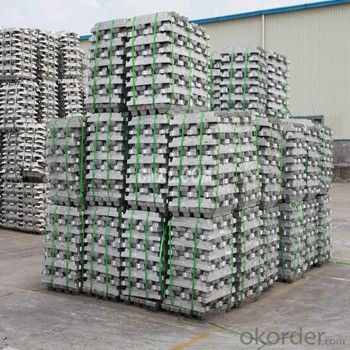
4.Aluminum Pig/Ingot Specification
Grade | Chemical Composition % | |||||||||
Al≥ | impurities ≤ | |||||||||
Si | Fe | Cu | Ga | Mg | Zn | Mn | others | Sum | ||
Al99.9 | 99.90 | 0.50 | 0.07 | 0.005 | 0.02 | 0.01 | 0.025 | - | 0.010 | 0.10 |
Al99.85 | 99.85 | 0.80 | 0.12 | 0.005 | 0.03 | 0.02 | 0.030 | - | 0.015 | 0.15 |
Al99.7 | 99.70 | 0.10 | 0.20 | 0.010 | 0.03 | 0.02 | 0.030 | - | 0.030 | 0.30 |
Al99.6 | 99.60 | 0.16 | 0.25 | 0.010 | 0.03 | 0.03 | 0.030 | - | 0.030 | 0.40 |
Al99.5 | 99.50 | 0.22 | 0.30 | 0.020 | 0.03 | 0.05 | 0.050 | - | 0.030 | 0.50 |
Al99.00 | 99.00 | 0.42 | 0.50 | 0.020 | 0.03 | 0.05 | 0.050 | - | 0.050 | 1.00 |
5.FAQ of Aluminum Pig/Ingot
We have organized several common questions for our clients,may help you sincerely:
①How about your company?
A big and famous and professional manufacturer & supplier of Aluminum Pig/Ingot, is one of the one of the large-scale professional investment Aluminum Pig/Ingot production bases in China.It have focuses on producing the Aluminum Pig/Ingot production for many years and gotten rich experience.Annually lagrge amount of Aluminum Pig/Ingot production are exported to markets in Europe,America and Japan. The quality and service have also gotten OEM service is available according to customer’s requirements.
②How to guarantee the quality of the products?
We have established the international advanced quality management system,every link from raw material to final product we have strict quality test;We resolutely put an end to unqualified products flowing into the market. At the same time, we will provide necessary follow-up service assurance.
③How long can we receive the product after purchase?
In the purchase of product within three wo We have organized several common questions for our clients,may help you sincerely:
①How about your company?
A big and famous and professional manufacturer & supplier of Aluminum Pig/Ingot, is one of the one of the large-scale professional investment Aluminum Pig/Ingot production bases in China.It have focuses on producing the Aluminum Pig/Ingot production for many years and gotten rich experience.Annually lagrge amount of Aluminum Pig/Ingot production are exported to markets in Europe,America and Japan. The quality and service have also gotten OEM service is available according to customer’s requirements.
②How to guarantee the quality of the products?
We have established the international advanced quality management system,every link from raw material to final product we have strict quality test;We resolutely put an end to unqualified products flowing into the market. At the same time, we will provide necessary follow-up service assurance.
③How long can we receive the prod rking days, We will arrange the factory delivery as soon as possible. The pecific time of receiving is related to the state and position of customers.Commonly 7 to 10 working days can be served.
- Q:How are aluminum ingots melted?
- Aluminum ingots are typically melted using a process called smelting. Smelting is the process of extracting a metal from its ore by heating it to a high temperature, causing the metal to melt and separate from the impurities. To melt aluminum ingots, a furnace is used, which is specifically designed to withstand the high temperatures required. The ingots are loaded into the furnace and heated to temperatures ranging between 660°C to 780°C (1220°F to 1436°F). The furnace is typically fueled by natural gas, oil, or electricity. Once the ingots reach the desired temperature, they begin to melt and transform into a liquid state. At this point, any impurities or foreign materials present in the ingots separate and rise to the surface, forming a layer called dross. The dross is then removed from the surface of the molten aluminum using various techniques such as skimming or by employing specialized tools. After the dross is removed, the molten aluminum is ready for further processing or casting into various shapes. It can be poured into molds to create different products or further refined to meet specific requirements. The molten aluminum can also be alloyed with other metals to enhance its properties or mixed with additives to improve its strength, durability, or other desired characteristics. Overall, the process of melting aluminum ingots involves subjecting them to high temperatures in a furnace, allowing them to melt into a liquid state, removing any impurities, and then further processing or casting the molten aluminum as needed.
- Q:How are aluminum ingots used in the production of heat exchangers?
- Due to their excellent thermal conductivity, lightweight properties, and corrosion resistance, aluminum ingots find extensive use in the manufacturing of heat exchangers. These devices are responsible for transferring heat between multiple fluids, and aluminum ingots play a vital role in enhancing their efficiency and durability. Firstly, the thermal conductivity of aluminum surpasses that of many other metals, making it an ideal material for heat exchangers. Its high thermal conductivity enables efficient heat transfer between fluids, resulting in rapid and effective temperature exchange. This quality proves especially advantageous in applications that require swift heat transfer, such as automotive radiators or air conditioning systems. Additionally, aluminum ingots offer a lightweight alternative to metals like copper or steel. This characteristic is particularly beneficial in industries where weight reduction is crucial, like aviation and automotive. The lightweight nature of aluminum ingots not only helps reduce the overall weight of the system but also facilitates easy handling and installation of heat exchangers. Moreover, aluminum ingots possess exceptional corrosion resistance, especially when exposed to harsh environments or corrosive fluids. This resistance is attributed to the formation of a thin protective oxide layer on the surface of the aluminum, preventing further oxidation and degradation. Heat exchangers often come in contact with various fluids, some of which may be corrosive. By utilizing aluminum ingots, the risk of corrosion-related failures is minimized, ensuring the long-lasting and reliable performance of the heat exchanger. Furthermore, aluminum ingots offer versatility in terms of fabrication and customization. They can be easily cast, extruded, or formed into complex shapes, allowing for the production of heat exchangers with intricate designs and optimized performance. This flexibility in manufacturing processes enables the production of heat exchangers tailored to specific requirements, further enhancing their overall efficiency and effectiveness. In conclusion, aluminum ingots are crucial components in the manufacturing of heat exchangers due to their superior thermal conductivity, lightweight properties, corrosion resistance, and versatility in fabrication. Their utilization significantly improves heat transfer efficiency, reduces weight, ensures durability, and allows for customization, making them the preferred choice in various industries.
- Q:How are aluminum ingots stored and transported?
- To ensure the safety and quality of aluminum ingots, they are typically stored and transported in a meticulous and organized manner. Warehouses or storage facilities that are specifically designed for handling metals are commonly used for storing the ingots. These facilities are equipped with proper ventilation, temperature control, and moisture protection to prevent any damage or contamination. When it comes to storage, aluminum ingots are usually placed on pallets or in racks, depending on their size and weight. The arrangement of the ingots allows for easy access and ensures stability during storage. In certain cases, individual wrapping or protective materials may be used to prevent scratching or surface damage. For transportation, different methods are employed depending on the distance and quantity of the ingots. Forklifts or hand trucks are typically used for shorter distances and smaller quantities. It is important to securely fasten the ingots to prevent any movement or potential falling during transport. For longer distances and larger quantities, trucks, trains, or ships are commonly used. Specialized containers or trailers are used to securely hold the ingots and protect them from external factors. In some cases, shipping containers or flatbed trailers are used to transport the ingots. During transportation, it is crucial to handle and secure the aluminum ingots properly to minimize the risk of damage or accidents. The transportation containers or vehicles should have appropriate padding or cushioning to absorb any shocks or vibrations that could affect the ingots. Overall, the storage and transportation of aluminum ingots require careful planning, adherence to safety protocols, and the use of specialized equipment to maintain their quality and integrity throughout the process.
- Q:What kind of material is die casting aluminium ingot?
- Material / model1, according to the content of aluminum ingot content is divided into1) advanced pure aluminum: aluminum content of 99.93%-99.999%2) industrial high-purity aluminum: aluminum content of 99.85%-99.90%3) industrial pure aluminium: the content of aluminium is 98.0%-99.7%2, remelting with aluminum ingot according to the chemical composition is divided into 6 grades: (Note: Al after the number is aluminum content)
- Q:What are the different cutting techniques for aluminum ingots?
- Depending on the desired outcome and specific application, aluminum ingots can be cut using various techniques. These techniques offer different advantages and limitations, making it important to consider factors such as cut quality, speed, shape complexity, and available equipment when choosing a method. One method is bandsaw cutting, which involves using a specialized blade on a bandsaw machine to cut through the ingot. This technique is commonly used for large-scale production due to its high precision and accuracy. Circular saw cutting is another option, where carbide-tipped blades on circular saws are used to cut the ingot. Suitable for both small and large-scale operations, this method offers a relatively fast cutting speed. Waterjet cutting is a technique that utilizes a high-pressure stream of water mixed with an abrasive material to cut through the ingot. Ideal for precise and intricate cuts, this method does not generate heat, minimizing the risk of thermal distortion. Plasma cutting involves melting and cutting the ingot using a plasma torch. This versatile method can be used for various thicknesses and shapes. Laser cutting, on the other hand, utilizes a highly focused laser beam to melt and vaporize the aluminum, resulting in a clean and precise cut. This technique is particularly effective for thin ingots. Shearing is a cutting technique that applies a shearing force to the ingot, typically using a guillotine-style machine. Suitable for cutting thicker ingots, this method can be used for both straight and curved cuts. To determine the most suitable cutting technique for a specific application, it is recommended to consult with experts or professionals in the field.
- Q:How do aluminum ingots contribute to the circular economy?
- Aluminum ingots contribute to the circular economy by being a key component in the recycling process of aluminum. As a highly recyclable material, aluminum ingots can be melted down and reused multiple times without losing their quality. This reduces the need for extracting and refining new aluminum from raw resources, conserves energy, and minimizes environmental impact. Additionally, the use of recycled aluminum ingots also reduces waste generation and promotes resource efficiency, making it an essential element in the circular economy model.
- Q:What is the role of aluminum ingots in the production of aircraft?
- Aluminum ingots play a crucial role in the production of aircraft as they are the primary raw material used in manufacturing various components, such as the fuselage, wings, and other structural parts. Due to its lightweight, high strength, and corrosion-resistant properties, aluminum is an ideal material for aircraft construction. The ingots are melted down and transformed into sheets, plates, and extrusions, which are then fabricated and assembled into the airframe. This versatile metal allows for weight reduction, increased fuel efficiency, and improved performance, making it an essential element in modern aircraft production.
- Q:What type of spectrometer is used to analyze aluminium ingots?
- If you want to analyze the aluminum ingot, first of all depends on the purity of the ingot, how many, if 4, 9 or 5 more than 9 of the aluminum ingot, it is recommended not to begrudge the price, buy high-end equipment, or else trace elements can not be analyzed.
- Q:How are aluminum ingots used in the production of marine vessels?
- The production of marine vessels heavily relies on aluminum ingots, which fulfill a crucial role. These ingots serve as the primary raw material for constructing different components and structures of the vessel, including the hull, superstructure, and other parts. The outstanding strength-to-weight ratio of aluminum ingots is one of the main reasons why they are preferred for marine vessel production. Being a lightweight metal, aluminum offers exceptional structural integrity, making it an ideal choice for building durable and agile vessels. Shipbuilders can utilize aluminum ingots to create robust and fuel-efficient vessels, resulting in improved performance and reduced operating costs. Additionally, aluminum ingots possess a high resistance to corrosion, which is a significant advantage in the marine environment. Traditional steel vessels are prone to severe corrosion caused by saltwater and harsh weather conditions, leading to maintenance issues and a shortened lifespan. The natural corrosion resistance of aluminum minimizes the need for extensive maintenance, ensuring the longevity of the vessel. Moreover, aluminum ingots are easy to work with and offer excellent formability. Shipbuilders can mold, bend, weld, and shape them into intricate designs required for marine vessel production. This flexibility allows for the creation of complex structures and optimization of the vessel's overall design, enhancing both performance and aesthetics. Furthermore, the use of aluminum ingots in marine vessel construction contributes to sustainability efforts. Aluminum is a highly recyclable material, and incorporating recycled aluminum in the production process significantly reduces energy consumption and greenhouse gas emissions. This aligns with the increasing emphasis on eco-friendly practices in the maritime industry. In conclusion, aluminum ingots are an indispensable component of the marine vessel production process. Their lightweight nature, strength, corrosion resistance, formability, and recyclability make them an excellent choice for constructing vessels that are efficient and sustainable.
- Q:How are aluminum ingots used in the production of automotive parts?
- The automotive industry relies heavily on aluminum ingots as they serve as the raw material for manufacturing lightweight and long-lasting components. Aluminum's use in this industry has gained significant traction due to its exceptional properties, such as its high strength-to-weight ratio, resistance to corrosion, and efficient thermal conductivity. Once obtained, aluminum ingots undergo a series of manufacturing processes to convert them into automotive parts. Initially, the ingots are melted in a furnace, resulting in molten aluminum. This liquid metal is then poured into a mold or cast, giving it the desired shape for the automotive part. This casting process allows for the production of intricate designs and complex shapes that would be challenging to achieve with other materials. Following the casting process, the newly formed automotive part undergoes additional treatments to enhance its mechanical properties. These treatments may include heat treatment, surface finishing, and machining. Heat treatment improves the material's strength and hardness, while surface finishing processes like polishing or coating provide a visually pleasing appearance and smooth texture. Machining processes such as milling, drilling, and cutting are also performed to ensure precise dimensions and a perfect fit within the vehicle. Aluminum ingots are commonly employed in the production of various automotive parts, including engine blocks, cylinder heads, pistons, wheels, transmission cases, and structural components. The lightweight nature of aluminum allows for reduced vehicle weight, resulting in enhanced fuel efficiency and reduced emissions. Furthermore, aluminum's excellent thermal conductivity aids in dissipating heat generated by the engine, contributing to improved overall performance and longevity. In conclusion, aluminum ingots are vital in the production of automotive parts due to their lightweight, durable, and corrosion-resistant properties. Through the casting, heat treatment, surface finishing, and machining processes, these ingots are transformed into high-quality components that are crucial to the automotive industry's pursuit of efficiency, performance, and sustainability.
1. Manufacturer Overview |
|
|---|---|
| Location | |
| Year Established | |
| Annual Output Value | |
| Main Markets | |
| Company Certifications | |
2. Manufacturer Certificates |
|
|---|---|
| a) Certification Name | |
| Range | |
| Reference | |
| Validity Period | |
3. Manufacturer Capability |
|
|---|---|
| a)Trade Capacity | |
| Nearest Port | |
| Export Percentage | |
| No.of Employees in Trade Department | |
| Language Spoken: | |
| b)Factory Information | |
| Factory Size: | |
| No. of Production Lines | |
| Contract Manufacturing | |
| Product Price Range | |
Send your message to us
Aluminum Pig/Ingot With Different Purity For Choice
- Loading Port:
- China main port
- Payment Terms:
- TT OR LC
- Min Order Qty:
- 1000 m.t.
- Supply Capability:
- 100000 m.t./month
OKorder Service Pledge
OKorder Financial Service
Similar products
New products
Hot products
Hot Searches
Related keywords
